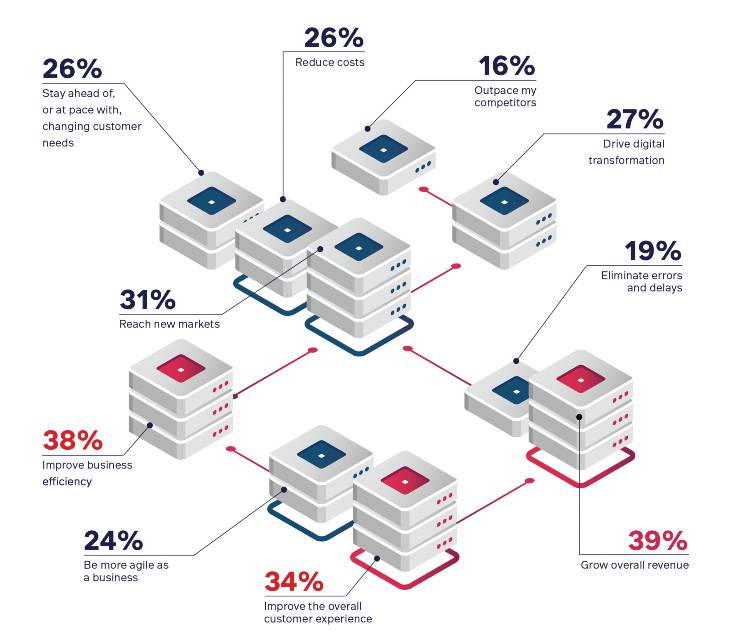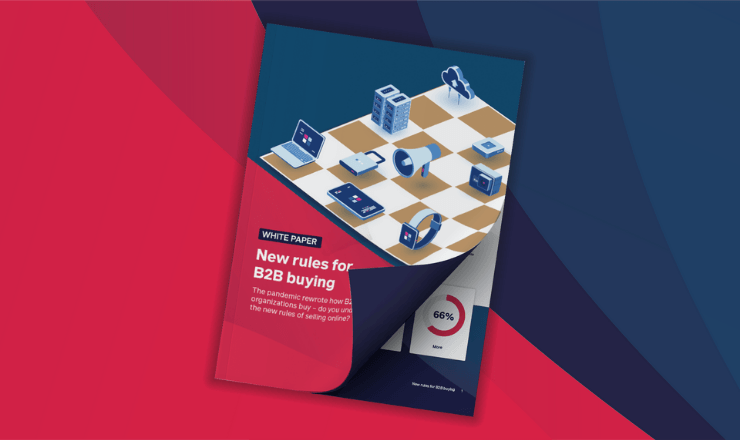

Manufacturers, your buyers’ number one preferred channel is e-commerce.
Our latest buyer report shows that 73% of global buyers prefer e-commerce over any other channel — email, phone, in person, or fax.
However, not all buyers are happy. 75% would be willing to switch to a supplier who offers a superior online buying experience.
Think about that: three-quarters of all buyers in the manufacturing industry are up for grabs.
Investing in e-commerce is critical. Not only does it help retain valuable business relationships, but it helps manufacturers expand their customer base.
The benefits of e-commerce for the manufacturing industry don’t stop there; there are numerous benefits to buyers and internal stakeholders that e-commerce provides.
Here are the top benefits that manufacturers can realize through embracing e-commerce.
Why do manufacturers (and their customers) need e-commerce?
Transformation in the manufacturing industry is being driven by consumer behavior —71% of all buyers are now millennials or Gen Z. These buyers are digital natives — they grew up with the advent of online ordering. As groundbreaking features such as 2-day shipping and one-click shopping became standard in their personal lives, these buyers began to raise their expectations of shopping in their business lives.
If I, as a consumer, can buy laundry detergent with the click of a button, then why can’t I, as a B2B buyer, buy business critical products just as easily?
Manufacturers that still primarily serve clients through phone, fax, or email risk losing the loyalty of these customers, especially as their worlds and preferences become even more digitally driven.
The good news is that B2B companies are responding to these new expectations. According to McKinsey, 65% of all B2B companies, regardless of industry, now offer e-commerce capabilities — up from 53% in 2021.
For manufactures specifically, it is clear that the industry has accepted the move to digital. According to our data in The Manufacturing & E-Commerce Benchmark Report, 98% of manufacturers have, are, or are planning to implement an e-commerce strategy. On top of that, 42% of the manufacturers who have invested in e-commerce and digital recognize improved customer relationships as a result.
In this same study, manufacturers reported that more than half of their overall revenue was generated via online sales channels. Manufacturers have come a long way since 2021 when 80% of manufacturers still depended primarily on their internal sales force to drive revenue.
However, as previously reported, 75% of buyers would switch to a supplier who offered a superior online buying experience. Manufacturers must continuously work to iterate and evolve their e-commerce offerings to stay ahead of the competition.
According to our buyer report, today’s B2B customers want to be in control of their experience online. Customers expect to be able to rely on accurate information, whether it is inventory levels, pricing, product details, order history, or their own negotiated discounts. They also want to be able to order wherever they are at any time.
That convenience doesn’t just benefit buyers. If a buyer in Peru wants to order a spare part for a hydraulic lift from a company in Austria, they would only have one business hour each day to connect via phone or email. With e-commerce, the buyer and seller don’t face this time zone constraint.
Convenience is just the tip of the iceberg; both buyers and sellers in the manufacturing industry stand to gain a lot from the benefits offered by e-commerce.

How do manufacturers benefit from e-commerce?
The advantages of e-commerce for manufacturers are clear: If you can provide a convenient and informative online buying experience for your B2B customers, you will be their go-to supplier. But the benefits extend beyond winning more customers; manufacturers can save significant time and reduce errors through embracing e-commerce.
1. Provide your clients with a personalized shopping experience.
As a company in the manufacturing industry, you may have an extensive product catalog that you want to share with your customers. But prices for these products can vary depending on the customer, segment, or other factors. As a result, you may hesitate to share your pricing information online.
Online buyer portals allow manufacturers to provide tailored catalogs with customized pricing, curated products, localizations, and personalized product suggestions based on your customers’ needs. These features not only improve the buyer journey, they help you increase conversions through cross and upsell opportunities.
Price and product personalization are both possible with a B2B web store, by connecting your assortment to a personalized account. If you are struggling with a large product catalog, you take a look at these tips on how to offer your entire catalog online.
2. Reduce order errors
Order errors are one of the largest sources of buyer frustration. 33% of all B2B orders placed in 2025 contained an error — a shockingly high percentage. These order errors have multiple knock-on effects. Buyers become frustrated as they must initiate returns to get their proper order, and they must delay services to their clients as they wait on the correct products they need to conduct their business.
Sellers end up shouldering costs of expensive returns and face frustrated buyers who may look for other suppliers.
When your e-commerce solution is integrated with your business logic, your customers always have the most accurate product, stock, price, and delivery information. This eliminates costly order errors — improving business for both buyer and seller.
3. Ensure visibility for spare parts
Businesses in the manufacturing industry often have high traffic for spare parts. An ERP-integrated e-commerce platform lets you match these spare parts with the more complex products customers have purchased. This makes cross-selling and upselling easy and efficient. As a result, customers don’t have to spend any effort on searching for connecting parts. This application of e-commerce for manufacturing helps improve both service and efficiency.
4. Enable customers to configure products online
Another advantage of e-commerce for manufacturing is the ability to visualize and configure products online. Your customers can configure and match products that differ in shape, size and color in your e-commerce platform. Groundbreaking features such as 3D product configurator allow buyers to manipulate products and see them placed within their future environment. This means your customers can customize products to their own requirements, without the help of your sales or support department. This saves both your customers and your company time and effort.

E-commerce challenges impacting your customer relationships?
Find out how to improve your customer relationships with The Manufacturing & E-Commerce Benchmark Report.
5. Save time by automating processes
This benefit is for both buyer and seller. With offline commerce channels, manual processes run rampant. Sales reps have to manually take down information from phone orders or tediously copy over information from email orders. Reconciling these orders against business logic is time-consuming and can lead to order errors — further eating into valuable time.
Buyers also face time constraints with offline ordering. Phone calls or lengthy email chains eat into working hours, preventing buyers from engaging in more proactive tasks.
With e-commerce, buyers can place orders at any time of day. These orders automatically are reconciled with the seller’s internal business logic, eliminating the need for manual data entry.
How much time can be saved? Alliant Power saved over 100 hours a month on manual order entry by embracing e-commerce.
6. Sell your complete assortment online
As a manufacturer, your catalog can contain thousands of products. Of these products, only a small percentage is purchased by the average client.
Adding a B2B web store to your sales channels helps you inform your customers about your complete assortment. Tools like quick search, search filters, and search suggestions will guide customers through the complete inventory of products. Customers can now learn about new and additional products, as well as alternatives.
7. Attract new customers
Search engines, such as Google or Bing, play a significant role in how (potential new) customers find you. During the B2B buying process, almost half of customers conduct web searches to look for information, solutions and suppliers.
Therefore, having a strong online presence, optimized for search engines, is key to reaching new prospects and staying ahead of the competition. Google and other search engines can then connect your customers to the valuable information you provide online.

What’s the best way for manufacturers to launch an e-commerce solution?
The manufacturing industry is complex, and transplanting your business to an online environment with minimal disruption can sound like a challenge. But it doesn’t have to be. Modern B2B e-commerce solutions like Sana Commerce are designed to easily integrate with your critical business logic such as ERPs, PIMs, and PSPs.
As long as you choose the right e-commerce partner, you have a strong foundation.
Whether your business is looking to upgrade your B2B e-commerce solution, or looking to implement your first e-commerce channel, the first step you need to take is to identify which type of solution is best for your business.
Our e-commerce software guide can help manufacturers discover which type of e-commerce solution is right for your business.
With a B2B-first e-commerce solution like Sana Commerce, you can get a handle on the complex B2B sales process by merging online sales with offline logistics and operations — boosting average order values by 70% and conversion rates by 200%.
What is the business impact of e-commerce on the manufacturing industry?
E-commerce isn’t only about buying and selling online. It’s not just about engaging customers online either. E-commerce should be a business tool and should allow your organization to benefit from larger digital transformation and business evolution initiatives.
For many manufacturers who have already invested in e-commerce strategically, this has proven true:
- 39% of manufacturers report overall revenue growth as a benefit of e-commerce
- Over one-third of manufacturers say that e-commerce improved customer experience
- 38% of manufacturers report that e-commerce improved their business efficiency

Source: The Manufacturing & E-Commerce Benchmark Report 2021, Figure F
For more data like this, and insights into how manufacturing e-commerce, supply chain optimization and business transformation can all work together to take your organization to the next level, read the latest 2021 data from The Manufacturing & E-Commerce Benchmark Report.

Mastering Complexity: How Alliant Power Streamlined Operations
Watch the on-demand session to see how Alliant Power streamlined operations and survived a ransomware crisis with Sana Commerce



